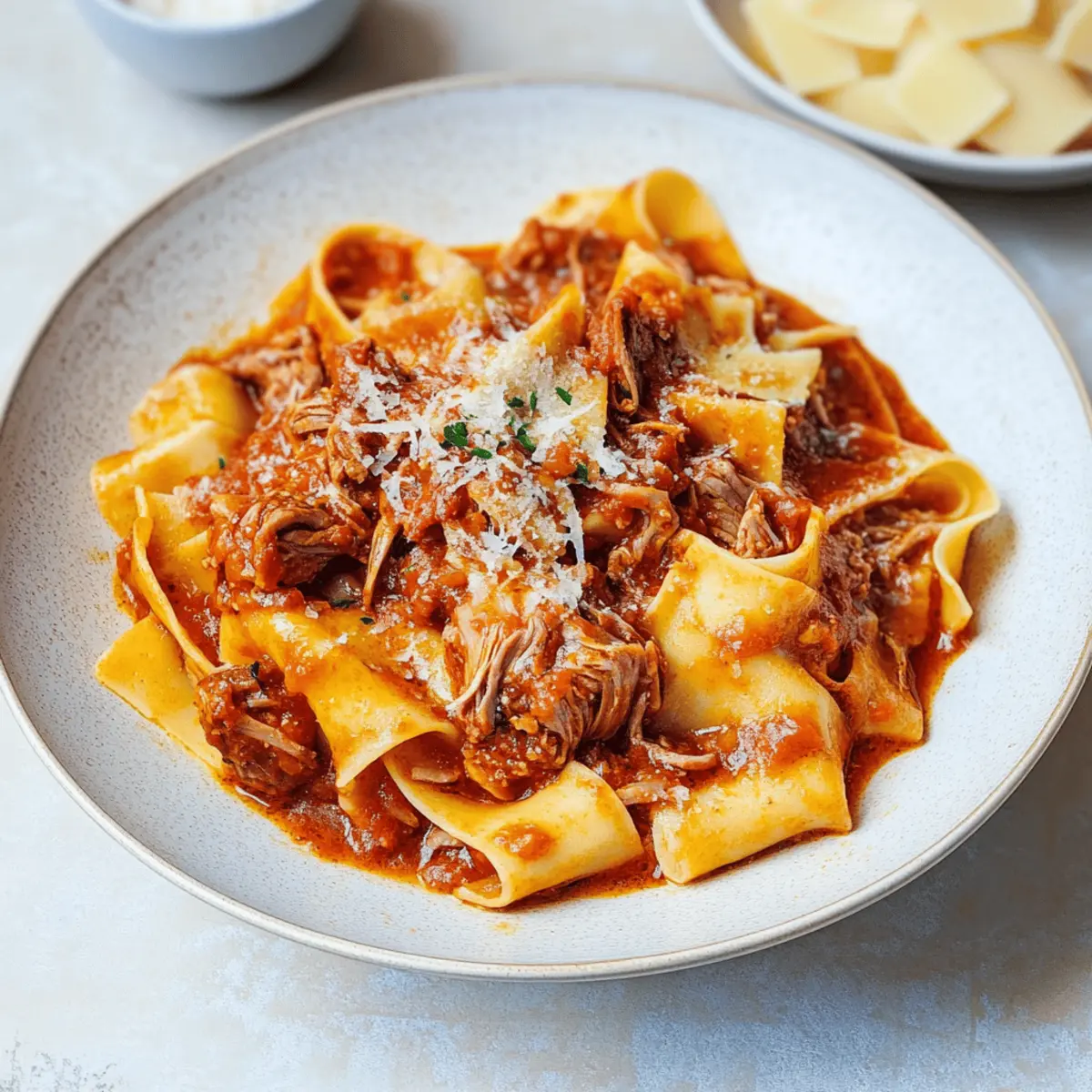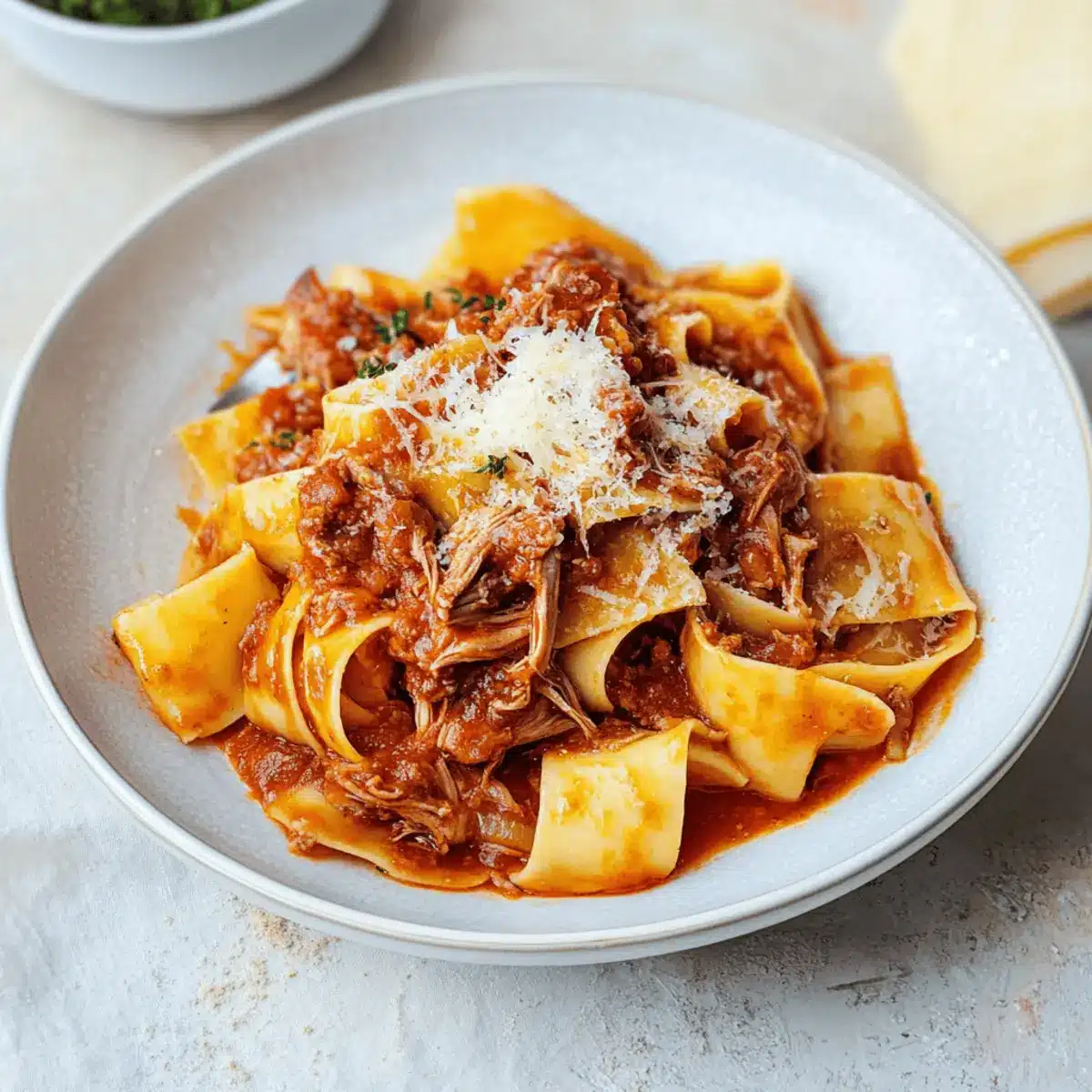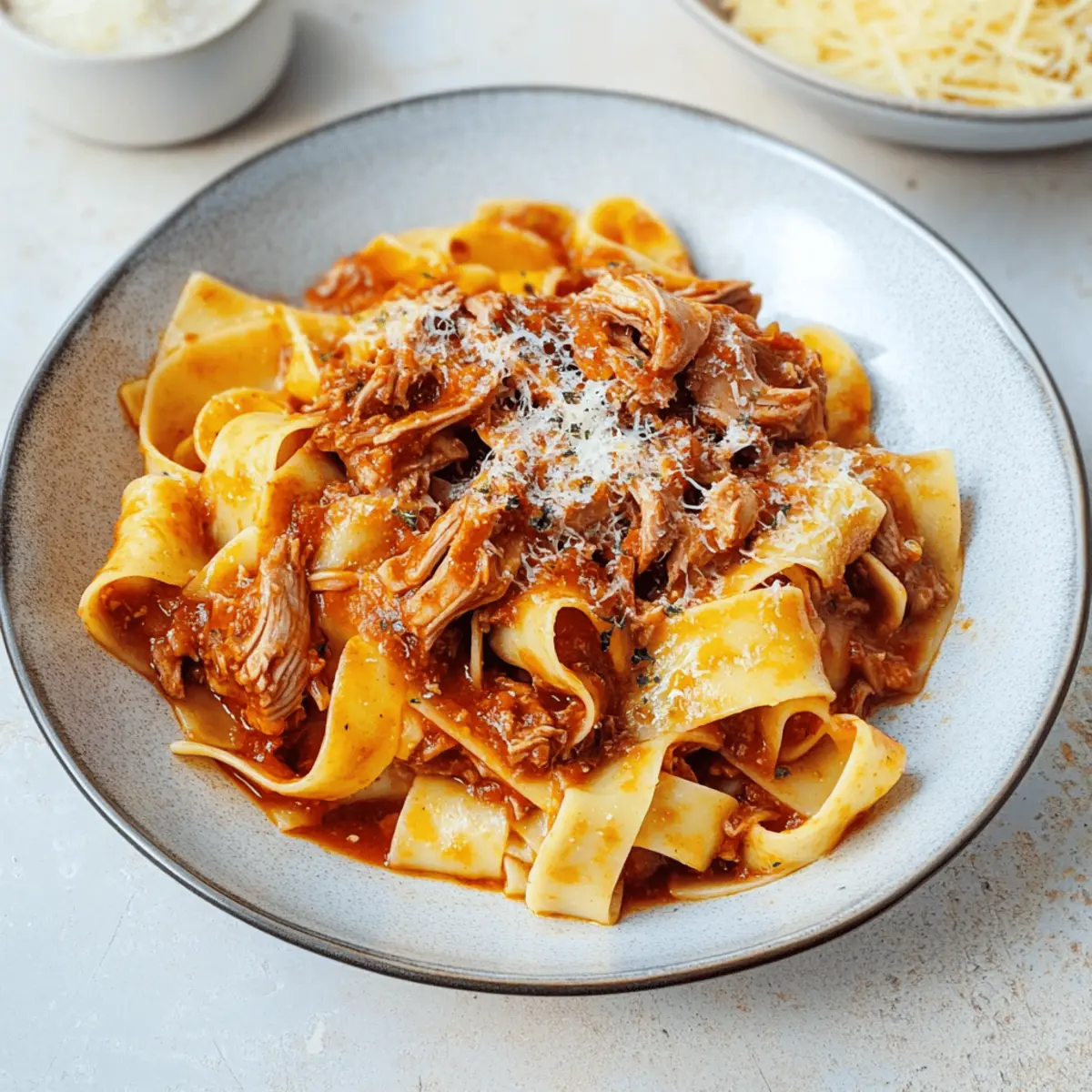As I ladled the rich, savory Duck Ragu over al dente pappardelle, an aromatic wave hit me, transporting me straight to a rustic Tuscan kitchen. This delightful dish, inspired by traditional Italian comfort food, is not only a slow-cooked masterpiece but also a uniquely gratifying experience. The tender, shredded duck simmered in a richly textured tomato sauce creates a heartwarming meal that’s perfect for family gatherings or cozy nights in. Plus, it doubles as an easy make-ahead option for busy weeknights, allowing flavors to deepen overnight. Curious how to bring this mouthwatering Duck Ragu to your own table? Let’s dive into the cooking process together!

Why is Duck Ragu so special?
Flavorful Experience: The depth of richness from slow-cooked duck combined with perfectly balanced spices makes every bite unforgettable.
Versatile Dish: Serve it over pappardelle, gnocchi, or even polenta – this ragu adapts beautifully to your preference!
Comforting Heirloom: This dish captures the essence of Italian countryside cooking, bringing warmth and nostalgia to the table.
Make-Ahead Magic: Prepare it in advance, and let the flavors meld overnight for a truly amazing meal that’s ready when you are!
Crowd-Pleaser: Perfect for family dinners or a dinner party, it’s sure to impress everyone and create delicious memories. Consider pairing it with some hearty sides, just like my delicious Short Rib Ragu for a full Italian feast!
Duck Ragu Ingredients
For the Ragu
• Olive oil – Adds fat for cooking and flavor. Use high-quality oil for best results.
• Duck legs (3, 1.6 lbs/750g) – This main protein provides a rich flavor; can substitute with chicken thighs if unavailable.
• Prosciutto crudo (5 slices) – Adds depth and umami; omit if you prefer a lighter dish or have dietary restrictions.
• Medium onion (1) – Serves as the base flavor for the sauce. Substitute with shallots for a milder taste.
• Celery stalk (1) – Provides aromatics; can replace with fennel for a different flavor profile.
• Medium carrot (1) – Adds sweetness and color; no substitute required.
• Garlic (4 cloves) – Essential for flavor; adjust quantity based on personal preference.
• Rosemary (2 twigs) – Infuses the sauce with herbal notes; omit if unavailable; dried rosemary can be used.
• Dried porcini mushrooms (3 pieces, optional) – Enhances the umami flavor; fresh mushrooms can be used instead.
• Dry white or red wine (1/2 cup) – Adds acidity and depth; substitute with chicken broth for a non-alcoholic version.
• Chicken or duck broth (2 cups) – Provides liquid for simmering and flavor; use vegetable broth for a vegetarian option.
• Tomato passata (1 jar/700 ml, or 2 cans crushed tomatoes) – The base of the sauce that gives it that characteristic tomato flavor; no direct substitutions recommended.
For Serving
• Pappardelle pasta – The traditional pasta pairing for serving; substitute with tagliatelle or fettuccine if needed.
• Grated parmesan cheese – Adds a savory finish; can be omitted for a dairy-free version.
Step‑by‑Step Instructions for Duck Ragu
Step 1: Prepare the Duck
Trim excess fat from the duck legs, ensuring a leaner Duck Ragu. Season generously with salt and pepper, creating a savory base for your dish. This step sets the stage for rich flavor, so take a moment to really coat the meat well.
Step 2: Brown the Ducks
In a large pot or Dutch oven, heat a tablespoon of high-quality olive oil over medium heat. Once hot, carefully add the seasoned duck legs, browning them for about 4-5 minutes on each side until they are beautifully golden. Remove the duck and set aside, allowing all those delicious juices to remain in the pot.
Step 3: Sauté the Prosciutto and Vegetables
Add the slices of prosciutto to the same pot, cooking them for 3-4 minutes until they are crisp. Next, toss in the chopped onion, carrot, celery, and rosemary, sautéing until the vegetables soften and the onion becomes translucent, around 5-6 minutes. This fragrant mixture is the heart of your Duck Ragu.
Step 4: Introduce Garlic and Mushrooms
Stir in the minced garlic and dried porcini mushrooms, if using, sautéing for an additional 1-2 minutes until fragrant. The garlic will release a rich aroma that enhance the flavor of your Duck Ragu, providing the base for an irresistible sauce.
Step 5: Deglaze the Pot
Pour in ½ cup of dry white or red wine, using a wooden spoon to scrape up any browned bits from the bottom of the pot. Let it cook on medium-high heat until the wine reduces by half, which should take about 3-4 minutes. This adds depth to your Duck Ragu, elevating its flavor profile.
Step 6: Combine Liquids
Add 2 cups of chicken or duck broth and 700 ml of tomato passata to the mixture. Stir well to combine, ensuring that the tomato sauce melds with the broth. Return the browned duck legs to the pot, ensuring they’re submerged in the liquid for optimal cooking.
Step 7: Slow Simmer the Ragu
Bring the pot to a gentle simmer over low heat. Cook uncovered for 2 to 2.5 hours, turning the duck legs halfway through for even cooking. The meat will become tender and easily fall from the bone, creating that perfect Duck Ragu experience.
Step 8: Shred the Duck
Once the duck legs are cool enough to handle, carefully remove them from the pot, discarding the bones and skin. Shred the tender meat with two forks, returning it to the pot. This step enriches your Duck Ragu with hearty duck pieces, creating a comforting dish.
Step 9: Final Touches
Adjust seasoning as necessary, adding salt and pepper to taste, and gently heat through for about 5 minutes. This ensures that all the flavors are balanced and fully melded, allowing your Duck Ragu to shine.
Step 10: Serve and Enjoy
Serve this delicious Duck Ragu over al dente pappardelle, allowing the pasta to soak up the rich sauce. Top with freshly grated Parmesan cheese, if desired, for an added savory finish. This dish is sure to be a warm, inviting centerpiece for your table.

What to Serve with Slow-Cooked Duck Ragu with Pappardelle
Picture the warm aroma wafting through your kitchen as you create the perfect meal around this delightful ragu.
-
Creamy Polenta: This smooth side complements the richness of the Duck Ragu, providing a luxurious cushion. The polenta’s subtle flavor allows the savoriness of the ragu to shine through.
-
Garlic Bread: Crunchy and buttery, the perfect accompaniment to soak up every last drop of the ragu. Imagine the pleasure of dipping a slice into the hearty sauce; it’s a match made in heaven!
-
Roasted Seasonal Vegetables: A platter of caramelized veggies provides freshness and vibrant color, balancing the richness of the dish. Consider carrots, zucchini, and bell peppers for their sweet roasted flavors.
-
Wine Pairing: A glass of medium-bodied red wine, such as Chianti, enhances the ragu’s flavors beautifully. The wine’s acidity complements the tomato base, creating a harmonious dining experience.
-
Simple Arugula Salad: Tossed in a light vinaigrette, the peppery greens will bring a crisp contrast to the dish’s richness, refreshing your palate with each bite.
-
Tiramisu for Dessert: End your meal on a sweet note with this classic Italian dessert, contrasting the savory ragu. Its creamy texture and coffee flavor will be the perfect finishing touch to your culinary journey.
How to Store and Freeze Duck Ragu
Fridge: Store Duck Ragu in an airtight container for up to 3-4 days. Make sure it cools completely before refrigerating to maintain its rich flavor and texture.
Freezer: For longer storage, freeze the ragu in a freezer-safe container for up to 3-4 months. Be sure to leave some space at the top, as the sauce will expand while freezing.
Reheating: When ready to enjoy, thaw in the fridge overnight, then reheat on the stovetop over low heat. Stir occasionally until heated thoroughly, adding a splash of broth if the sauce is too thick.
Make-Ahead Tips: You can prepare the Duck Ragu in advance, making it perfect for busy weeknights or special occasions, allowing flavors to deepen overnight before serving.
Duck Ragu Variations & Substitutions
Feel free to get creative with this comforting Duck Ragu—your meal can be as unique as your taste buds!
- Dairy-Free: Omit the grated parmesan cheese or sprinkle with nutritional yeast for a vegan-friendly finish.
- Meat-Free: Swap the duck legs with hearty mushrooms like portobello for a flavorful vegetarian alternative.
- Wine-Free: Replace the wine with ½ cup of apple cider vinegar mixed with water to enhance acidity without alcohol.
- Herb Twist: Experiment with different herbs like thyme or sage to create an aromatic profile that excites your palate!
- Extra Umami: Add a dash of soy sauce or fish sauce during cooking to intensify the saucy goodness, giving it a delightful depth.
- Texture Boost: Stir in some finely chopped spinach or kale towards the end of cooking for a nutritious and vibrant addition.
- Spicy Kick: Add crushed red pepper flakes or a dash of cayenne pepper to introduce warmth and balance the richness of the sauce.
- Alternative Pastas: Don’t feel limited to pappardelle. Use orecchiette or fusilli for a unique twist; they pair beautifully with sauces.
These variations not only elevate your Duck Ragu but also remind us that cooking is all about personal expression! For a heartwarming meal like my beloved on-the-bone Short Rib Ragu, explore the possibilities and make it your own!
Make Ahead Options
These Duck Ragu preparations are perfect for busy weeknights! You can fully prepare the ragu up to 24 hours in advance, as allowing it to chill enhances the flavors overnight. After cooking, let the ragu cool completely and transfer it to an airtight container to refrigerate. It will stay good for 3-4 days in the fridge or can be frozen for up to 3-4 months. When you’re ready to serve, simply reheat the Duck Ragu on the stove over low heat, stirring gently to maintain its creamy texture. This makes your mealtime not just convenient but just as delicious as when freshly made!
Expert Tips for Perfect Duck Ragu
- Fat Control: Render excess fat from duck legs before cooking to avoid a greasy sauce, ensuring a lighter finish.
- Flavors Overnight: For deeper flavors, allow the finished Duck Ragu to sit overnight. This will enhance the richness and complexity.
- Tomato Quality Matters: Use high-quality canned tomatoes for your sauce. Avoid overly acidic brands to maintain a balanced flavor profile.
- Gentle Simmering: Cook the ragu slowly but maintain a gentle simmer for the most tender meat. This helps the flavors meld beautifully.
- Pasta Pairing: While pappardelle is traditional, don’t hesitate to experiment with other pasta types, such as tagliatelle or gnocchi.

Duck Ragu Recipe FAQs
How do I choose the right duck legs?
Look for duck legs that are deep in color, with a good amount of fat, which enhances cooking flavor and texture. Avoid any legs with dark spots or an off smell. For a substitute, chicken thighs can also provide a tasty result if duck legs aren’t available.
What’s the best way to store leftover Duck Ragu?
Cool the Duck Ragu completely before transferring it to an airtight container. It can be stored in the refrigerator for about 3-4 days. To maintain its rich flavor and texture, make sure the container is sealed properly to prevent air from entering.
Can I freeze Duck Ragu?
Absolutely! To freeze, pour the cooled ragu into a freezer-safe container, leaving some space at the top for expansion. It will last for up to 3-4 months. When ready to enjoy, thaw it overnight in the fridge before reheating.
What should I do if my Duck Ragu is too fatty?
If your sauce seems too greasy, let it cool entirely; the fat will solidify on top, making it easy to skim off. You can also adjust the fat content before cooking by trimming excess fat from the duck legs to keep the sauce lighter.
Are there any dietary considerations I should keep in mind?
Absolutely! Be sure to inform guests of any pork in the dish (due to the prosciutto), and if anyone has dairy allergies, Parmesan cheese can be omitted or substituted with a dairy-free alternative for a complete dish suitable for different dietary needs.
How can I ensure my Duck Ragu has the best flavor?
Cook the ragu slowly and allow it to sit overnight before serving. This method allows the flavors to meld beautifully, providing a richer, more complex sauce. When reheating, consider adding a splash of broth to maintain the right consistency.

Savory Duck Ragu That Will Warm Your Heart and Home
Ingredients
Equipment
Method
- Trim excess fat from the duck legs, season generously with salt and pepper.
- In a large pot, heat olive oil over medium heat and brown the duck legs for 4-5 minutes on each side.
- Add prosciutto to the pot and cook until crisp, then sauté onion, carrot, celery, and rosemary until softened.
- Stir in minced garlic and dried porcini mushrooms, sauté for an additional 1-2 minutes.
- Deglaze the pot with wine, scraping up browned bits and reduce by half, about 3-4 minutes.
- Combine chicken or duck broth and tomato passata, add the duck legs back into the pot.
- Bring to a gentle simmer and cook uncovered for 2 to 2.5 hours, turning the duck legs halfway through.
- Remove duck legs, shred the meat, and return it to the pot.
- Adjust seasoning, heat through for about 5 minutes, and serve over pappardelle.

Leave a Reply